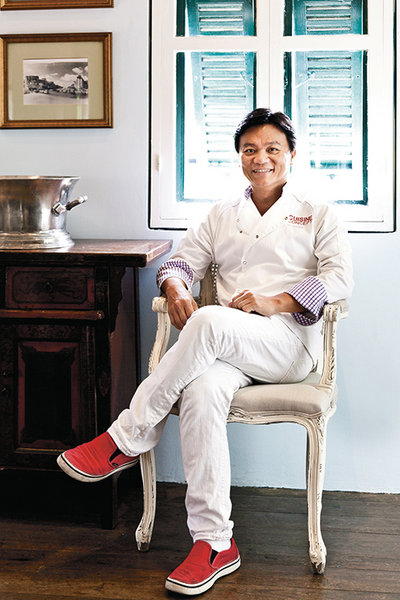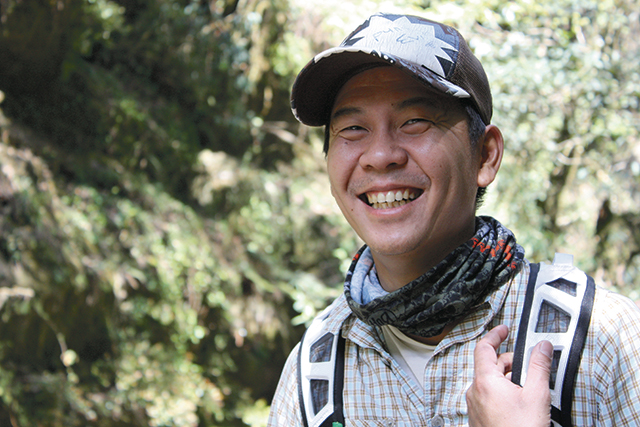In late July,
Seven Spoons and
Beervana teamed up to introduce a
craft beer pairing dinner showcasing foraged foods from around Southeast Asia. Among the indigenous ingredients on the menu were honey, mushrooms and Lao dragon nuts, all sourced from the wild. As more and more Bangkokians contemplate a locavore diet in the search for green, sustainable cuisine, we talk to prominent local chefs and organic farmers about foraging and what role it could play in our dining scene.
Ian Kittichai
What is Foraging Today?
Chef Ian Kittichai, of
Issaya Siamese Club, describes it as sourcing indigenous plants and ingredients from the forest, while Chef Somkiat Pairojmahakij, of Seven Spoons, says food can be foraged from any type of landscape: “To me, foraging means a super localized way to make do with what exists in the immediate natural environment.” Whether out of necessity or choice, foraging can take place anywhere, from forests to sidewalks. Bryan Hugill, co-founder of
Raitong Organics Farm, adds that the term also applies to fishing for fruits of the sea. Australian Chef Ben McRae, of
Issaya Cooking Studio, expands the concept even further to hunting and gathering. “It is the most self-assuring and satisfying way to go out and source our own ingredients,” he says. “Back in my childhood, we would go to the forest on weekends to hunt deer, kangaroos, and even wild goats.”
Somkiat Pairojmahakij
Why is Foraging Hot Now?
From San Francisco to Sao Paolo, the farm-to-table movement has evolved into what’s been dubbed “wilderness-to-table,” as concerns over sustainable, and ethical eating have spread. Restaurants like René Redzepi’s two-Michelin-star Noma, in Denmark, have been praised for their use of local and seasonal ingredients foraged from the forest and seashore. Now, slowly but surely, it’s arriving in Bangkok in the form of special dinners and menus.
Kittichai, however, suggests we were well ahead of the game. “HM King of Thailand has decreed growing forests as a way to provide more sustainable alternatives and substitutions for ingredients,” he says. “Once, I had the chance to walk in one of these forests and I was blown away by the amount of edible leaves. One of them tasted exactly like garlic, another like licorice, and the last one made me puke because it tasted exactly like giant water bugs.”
For Somkiat, the foraging trend suggests that diners may be growing bored with the “exotic” and more inclined to try ingredients that have always been around but never really incorporated into urban cuisines. “In the Golden Triangle, there’s the amazing Lao dragon nut, which has a lot of similarities with pine nuts—we are having a great time experimenting with these.”
Hugill points out that the foraging opportunities in Bangkok are endless: wild bananas in slums, lychees, other fallen fruits and mushrooms, which are quite easy to find from street vendors and local markets. McRae says the demand for foraged food is part of a wider trend for knowing exactly where our food is coming from: “Sourcing our own ingredients, either by ourselves or through a forager, is the healthiest option, and it is quite vital that we know how animals are treated, what they eat and the whole slaughtering process.”
“I had the chance to walk in one of these forests and I was blown away by the amount of edible leaves. One tasted exactly like garlic, another like licorice, and the last one made me puke.”
What’s Next for Foraging?
Somkiat says that Bangkok diners are overly concerned with looking to what is happening in London, New York and Rome. “In fact, what is happening there are moves towards local and foraged foods, and sustainability. This will gradually boomerang to Thailand and people will start to look more closely at what exists in our own backyards and national parks, while the culinary adventurers and mixologists of the world could soon be turning their eyes to Southeast Asia.”
Hugill explains that foraging in Thailand is limited by seasonality, climate and pollution, as well as perception, something Kittichai agrees with: “Right now, the concept of foraging is too advanced for Bangkok; there are too few sources and suppliers. Also, the general Thai perception is that most foraged plants are meant to be either boiled or eaten fresh along with nam prik.” That’s not to say foraging is not occurring here. Our experts point to Khlong Toey Market, Bangkok Farmers’ Market and Talad Kon Lao at Wongwian Yai as places that showcase foraged food, though McRae says you can never be too sure. “The word organic is so overused; I will say that only 50 percent of ‘organic produce’ is really organic.”
Essentials
The Forces Behind Foraged Food in Bangkok

Freeland Foundation
Working closely with national park officers, Freeland Foundation initiated a program to prevent illegal foraging from restricted forest areas. It educates the nearby community on organic farming, including mushrooms and asparagus. For more information, call
Beervana
Known for imported craft beers, Beervana also blazed a trail with dining events that feature foraged ingredients. Keep up to date at
www.seekbeervana.com or call 02-108-0387.
Issaya Cooking Studio
On Thursday, Sep 25, 6:30pm-10pm, Chef Ben McRae will prepare a five-course menu featuring the “wildly indigenous” bounties of New Zealand, paired with free-flow craft beer from Beervana. Only 18 seats available. B2,900 person. Contact
[email protected]. Eat Thai, G/F, Central Embassy, 1031 Phloen Chit Rd., 02-160-5636. BTS Phloen Chit.
www.facebook.com/issayastudio
Seven Spoons
22-24 Chakrapadipong Rd., 02-629-9214. Open Tue-Sat 11am-3pm, 6pm-1am; Sun 6pm-1am.
on.fb.me/1p9Ipic
Raitong Organics




